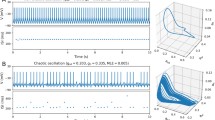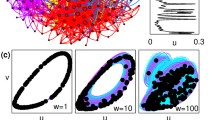Abstract
Phase synchronization is a mechanism that plays a crucial role in information processing in the brain, and coherence is one of the factors used to evaluate the pairwise degree of phase synchronization. Coherence is also an important measure for examining brain functions because it implies communication and cooperation among neurons. In this work, we study the coherence patterns of spontaneous activity in a neural field model at criticality where a second-order phase transition occurs with special properties that differentiate it from other regions. The results are summarized as follows. First, in high-frequency bands, the system outside the critical region is unable to communicate efficiently via phase synchronization. Second, the dynamical coherence patterns at the criticality show switching between high and low coherence states. Finally, we found that in a very brief period, there is high broadband coherence between some pairs of spatial points. This phenomenon can be observed only in the critical region.



Similar content being viewed by others
References
Beggs JM (2008) The criticality hypothesis: how local cortical networks might optimize information processing. Philos Trans R Soc A 366:329–343
Kinouchi O, Copelli M (2006) Optimal dynamical range of excitable networks at criticality. Nat Phys 2:348–351
Haldeman C, Beggs JM (2005) Critical branching captures activity in living neural networks and maximizes the number of metastable states. Phys Rev Lett 94(5):058101
Bertschinger N, Natschläger T (2004) Real-time computation at the edge of chaos in recurrent neural networks. Neural Comput 16(7):1413–1436
de Arcangelis L, Herrmann HJ (2010) Learning as a phenomenon occurring in a critical state. Proc Natl Acad Sci USA 107(9):3977–3981
Beggs JM, Plenz D (2003) Neuronal avalanches in neocortical circuits. J Neurosci 23(35):11167–11177
Henrie JA, Shapley R (2005) LFP power spectra in V1 cortex: the graded effect of stimulus contrast. J Neurophysiol 94:479–490
Freeman WJ, Rogers LJ, Holmes MD et al (2000) Spatial spectral analysis of human electrocorticograms including the alpha and gamma bands. J Neurosci Methods 95:111–121
Thurner S, Windischberger C, Moser E et al (2003) Scaling laws and persistence in human brain activity. Phys A 326:511–521
Eguíluz VM, Chialvo DR, Cecchi GA et al (2005) Scale-free brain functional networks. Phys Rev Lett 94(1):018102
Fox MD, Raichle ME (2007) Spontaneous fluctuations in brain activity observed with functional magnetic resonance imaging. Nat Rev Neurosci 8(9):700–711
Ito J, Nikolaev AR, van Leeuwen C (2005) Spatial and temporal structure of phase synchronization of spontaneous alpha EEG activity. Biol Cybern 92(1):54–60
Coombes S (2006) Neural fields. Scholarpedia 1(6):1373
Amari S (1977) Dynamics of pattern formation in lateral-inhibition type neural fields. Biol Cybern 27(2):77–87
Achermann P, Borbély AA (1998) Temporal evolution of coherence and power in the human sleep electroencephalogram. J Sleep Res 7(S1):36–41
Gervasoni D, Lin SC, Ribeiro S et al (2004) Global forebrain dynamics predict rat behavioral states and their transitions. J Neurosci 24(49):11137–11147
Acknowledgments
This research is partially supported by Grant-in-Aid for Scientific Research (A) (20246026) from MEXT of Japan and the Japan Society for the Promotion of Science, a Grant-in-Aid for JSPS Fellows (21•937).
Author information
Authors and Affiliations
Corresponding author
About this article
Cite this article
Termsaithong, T., Oku, M. & Aihara, K. Dynamical coherence patterns in neural field model at criticality. Artif Life Robotics 17, 75–79 (2012). https://doi.org/10.1007/s10015-012-0020-x
Received:
Accepted:
Published:
Issue Date:
DOI: https://doi.org/10.1007/s10015-012-0020-x




